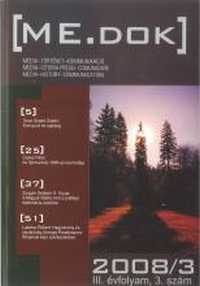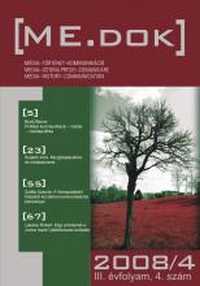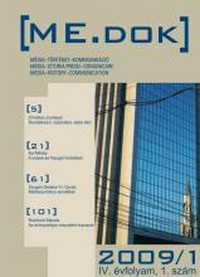
We kindly inform you that, as long as the subject affiliation of our 300.000+ articles is in progress, you might get unsufficient or no results on your third level or second level search. In this case, please broaden your search criteria.


At the basis of the appearance of virus-marketing lies the noise created by traditional media-based marketing. Traditional advertising channels are saturated to such an extent that advertisers are pushed to find and invent new and less saturated means and channels in order to get noticed. In his article the author deals with the adaptation techniques and methods of virus-marketing.
More...
This artricle analyses the issue No. 2008/3 of the journal Revista Română de Jurnalism şi Comunicare.
More...
Árpád Péter’s article deals with the medialisation of time and discourse. His conclusion is that time cannot be medialised for discourse. That only thing we can obtain in word is the metaphor of time, metaphor which is identified with time by discourse participating in/creating culture. This identification is not a mistake as there is no discursive alternative for these metaphors, but this in the same time makes impossible to analyse medial phenomena.
More...
Until the II WW the Hungarian Radio served as cultural communicational means and as builder and bearer of national unity rather than as communicational channel for actual political problems.The radio had three main objectives: to create effective communication within the state and between the center and the peripheries; to conserve the language, culture and loyalty to the Hungarian state of Hungarian people outside the borders of the Hungary who did not belong directly to the Budapest government; to create a positive Hungarian image on international scales, and to use it for political reasons in favor of the Hungarian state.
More...
For decades millions of desperate, oppressed people fallowed the broadcasting of RadioFreeEurope (RFE), without any knowledge about it’s background, it’s ways of functioning and it’s difficulties in gathering information. Despite being a private organization, RFE was sustained by public funds of the United States Congress. The headquarter was established in Munich and it transmitted from West Germany and Portugal. The Hungarian language programs were written and edited by Hungarian emigrants for Hungarians living in Hungary and outside it’s borders, in neighboring countries. According to Sándor Márai it was „a window to the world”, through which the listeners could take a look on a free welfare society. The author compares the current information gathering practices with those used by the RFE and concludes that nowadays it’s difficult to gather reliable information in Romania. Though the Mediafax and the Rador news agencies established Hungarian services, news of the Mediafax are poorly translated. The Rador agency, established by the Romanian Radio Society, only translates international news in Hungarian.
More...
In his work, Bodó retrospects the past twenty years of Hungarian public life in Romania.The author in his inference accentuates that the written media’s coverege is wider than the radio’s or the TV’s, and at the same time the Transylvanian cable network usually offers at least two, generally five or even six home country channels. This means that the local coverege is poorer than the written media, but on the whole it is still better. The author did a pioneering work in this subject, because he emphasizes those motives, from which resulted that almost every scandal related to the Hungarian politicians is missing from the press. Bodó presents the editing principles of the Transylvanian public and political blogs. He also analyses the Transylvanian newspapers’ coverege in the region. The author gives a detailed review about the Transylvanian Hungarians’ media consumption habits.
More...
This article threats the communications issues of Catholic Church of Transylvania.
More...
This article presents the scientific accomplishments of the Hungarian line of study, specialisation: communication and administration - from the BBU's extension from Sfantu Gheorghe (Szentgyőrgy)
More...
This article analyses the styling of radio and TV news in the Hungarian medias from Transylvania
More...
The communication campaigns of Roşia Montana represent a unique social, political and cultural moment in the history of Romania. Along the years these campaigns stand as a significant example for the battle between strategies, messages, instruments of a campaign and techniques of persuasion.For this reason the campaigns initiated by Alburnus Maior and Gabriel Resources offer the necessary source for a research in the domain of campaign theories, and constitute the case study in this analysis.
More...
This article analyses the importance of PR-trends and penetration rate in Romania. Tendinţe în PR şi publicitate: planificare strategică şi instrumente de comunicare. Ed. Tritonic, Buc., 2008
More...
In this paper the author offers a close reading of some historical sources connected to the great famine of 1661-1662 in France. The historian approaches these texts as communicational strategies during crisis-situation which are allowing to their authors to accomplish the royal will. In one hand we have the absolute power of the French monarch as the historical tradition presented it, and in the other it’s limits: the sources are evidencing the different corrective strategies facing the king’s decisions. The final oxymoron (bordered absolute power) argues that the monarchy needs to represent the absolute power in order to bequeath his heritage.
More...
The essay presents “the Sociographic crops” of the late ’60-es and early ’70-es in two major periodicals: the Utunk and the Igaz Szó. The author analysing Beke György’s, Benkő Samu’,Sütő András’s, Cseke Péter’s, Sylvester Lajos’s, Gálfalvi György’s, Bartis Ferenc’s etc. works assesses the alteration of the genre. Cseke’s major aim is to map the Transylvanian Hungarian minorities’ rugged fortune.
More...
The main question of this study constitutes the Nyugat periodical and it’s relation with the advertisings. Emphasizes and fully analyses a few important issues. It appoints that there was a close relationship between the booster and the editorial office. By the advertised products(books, bulbs etc.) we can conclude and circumscribe the periodical’s target group’s profile.
More...
In my paper I intend to establish connections between the practice of occasional poetry in18th century and the contemporary PR-profession. The theoretical background is illustrated by a brief case study related to the insurrection of the Romanian peasants in 1784. The parallelism between these two professions is assured by the connection of two systems: the system of representation and that of image-making. On the other side these similarities will be situated in their original historical context while they are also linked to the transformations of the public sphere.
More...
This article analyses the Transylvanian Journal of Communication Sciences, edited at by the Journalism and Communication Departments of BBU
More...
With the help of Kelemen Lajos’s autobiography and diary, the study presents the Transylvanian Museum Society’s significant member’s commitment for the Transylvanian Hungarian minorities scientific precession and his achievement for the culture and values..
More...
The (late-, post)modern people – who is dependent of the economic and technological developments – is daydreaming about living in a growing up Paradise. They run away from the everyday life, they travel, even in if this travel is an imaginary one. Visiting foreign cultures and tracing the local life stories became the centre of the anthropological research – under the title of global village. The wish for documentation and self-confessions are increasing. Science is bending with interest towards the village stories.Hence anthropologist attest indestructible wish to describe the neighbor’s stories.
More...
This essay draws Harold Adams Innis’s, James W. Carey’s, Herbert Marshall McLuhan’s,Joshua Meyrowitz’s and Vilém Flusser’s media-theory’s critical dissection.
More...